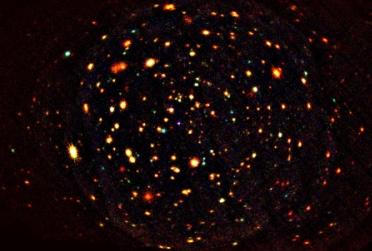Active black holes: Ultra-hot cosmic beacons
What astronomers can see once a black hole has heated up its cosmic neighbourhood, stimulating it to emit bright radiation
An article by Andreas Müller
The black holes of main interest to astrophysicists are either of the stellar or of the supermassive variety. Taken by themselves, they are as black as their name indicates, and correspondingly difficult to observe. Yet under the right circumstances, these black holes can literally light up their surroundings – as long as they are continually “fed” with infalling matter!
Accretion disks and flows
Commonly, when matter falls towards a black hole, it accumulates to form what is called an accretion disk – a swirling disk of matter orbiting the black hole. By one of the most general laws of physics, all objects emit thermal radiation, with the specific properties of that radiation depending on an object’s temperature. The typical temperature of accretion disks is high enough to produce large amounts of ultraviolet or radiation or even highly-energetic X-rays. (More information on accretion disks can be found in the spotlight topic Luminous disks: How black holes light up their surroundings.) The exact temperature depends on the mass of the black hole; stellar black holes with their much smaller masses lead to hotter accretion disks than supermassive black holes.
Not all of the radiation produced in the immediate neighbourhood of black holes is thermal in nature. If the “feeding rate” of the black hole – the inflow of matter onto the accretion disk – is moderate, then an important source of thermal, but also of non-thermal radiation can develop: an overheated plasma flow streaming from the inner rim of the accretion disk into the black hole. This flow can reach temperatures a few hundred or even a few thousand times as high as those in the hottest region of the disk. Owing to those high temperatures, the plasma expands, its density decreases, and the flow drapes itself around the black hole in the shape of a sphere surrounding the black hole, or of a winding tube – for the latter, the basic arrangement is sketched in the following illustration, which shows a cross-section view of the disc, the accretion flow and the black hole:
![Black hole / inner accretion flow / accretion disc [image: Andreas Müller, MPE / Redesign: Daniela Leitner] Black hole / inner accretion flow / accretion disc [Bild: Andreas Müller, MPE / Redesign: Daniela Leitner]](https://www.einstein-online.info/wp-content/uploads/black_holes_and_co_accretion_disc_plasmajet_black_hole_©_Andreas_Mueller_MPE_Redesign_Daniela_Leitner.jpg)
[image: Andreas Müller, MPE / Redesign: Daniela Leitner]
For visible light, the plasma flow’s gas is almost completely transparent. There are, however, scattering processes, with photons (from the thermal radiation of the accretion flow and even from the cosmic background radiation) being absorbed and re-emitted by the electrons of the plasma. This scattering is an efficient way to transfer energy from the electrons to the lower-energetic parts of the ambient radiation, transforming it into highly energetic X-rays or even gamma rays.
Together, the two mechanisms – thermal radiation and the production of gamma rays in the plasma current – are responsible for two main classes of astronomical objects, observable with the help of X-ray and gamma-ray telescopes: X-ray binaries and active galactic nuclei. The two classes correspond to the two main classes of black holes – stellar and supermassive.
X-ray binaries
We’ll begin with the X-ray binaries – double star systems in which a normal star and a compact object orbit each other. The brightest X-ray source in the constellation Swan, which astronomers call Cygnus X-1, is a prominent example. The following image was produced from data taken in late 2002 with the European Space Agency’s INTEGRAL satellite:
![[Image: ESA/INTEGRAL] [Image: ESA/INTEGRAL]](https://www.einstein-online.info/wp-content/uploads/black_holes_and_co_Cygnus-X-1_©_ESA_INTEGRAL.jpg)
[Image: ESA/INTEGRAL]
Not every X-ray binary contains a black hole. It is equally possible for the compact object within the accretion disk to be a neutron star or even a white dwarf. However, whenever astronomers manage to measure the object’s mass, and that mass amounts to more than three solar masses, then to the best of current knowledge, the central object is indeed a black hole. More precisely, it is a stellar black hole (by definition, a black hole with a few or a few dozen times the mass of our sun). The stellar black hole in Cygnus X-1 has ten times the mass of the sun.
In the case of X-ray binaries, the “food” for the accretion disk around the compact object is provided by its partner, an ordinary star which astronomers call the “donator” of the pair. In the direct vicinity of the black hole, the accretion disk temperature reaches extreme values of about a hundred million Kelvin – about ten times the temperature in the centre of the sun! As mentioned before, matter at such high temperature emits high-energy thermal radiation, typically X-rays. The brightest black hole X-ray binaries emit more about a million times more energy in X-rays alone than our sun in the whole electromagnetic spectrum!
Active galactic nuclei
Compared to X-ray binaries, the members of the second class of astronomical objects are true behemoths. The compact objects involved are supermassive black holes with the same mass as millions or even billions of suns combined. Such black holes are not uncommon; in fact, astronomers have come to the conclusion that there should be at least one of them in the centre of all but a few galaxies. Some of these black holes are quiescent and inactive, like the gigantic black hole in the centre of our own Milky Way (compare the spotlight topic The dark heart of the Milky Way). We are interested in the other kind – those supermassive black holes that are spectacularly active, with infalling matter producing a variety of highly energetic phenomena for astronomers to observe. They are called active galactic nuclei (abbreviated to AGN). The most splendid representatives of this class are objects called quasars and blazars.
The image below shows approximately a hundred active galactic nuclei, located in a region of the sky that astronomers call the Lockman hole. This is, again, a false-colour image; this time, the different colours are associated with X-rays of different energies, from red via green to blue for X-rays of low, medium and high energy respectively. The observations were made with the space-based X-ray telescope XMM-Newton:

ESA/XMM-Newton, Hasinger et al.
Every bright spot in this image is an active galactic nucleus, whose X-rays have travelled for almost 12 billion years in order to reach us (corresponding to a cosmological redshift of z = 3.5). Each of these active nuclei should contain at least one supermassive black hole!
As far as the mechanism behind the bright X-ray emission is concerned, active galactic nuclei are very similar to X-ray binaries: The supermassive black holes tap the matter reservoir in their immediate galactic neighbourhood; interstellar gas and dust from the innermost regions of the host galaxy are pulled towards the black hole, where they form an accretion disk. The disk material reaches impressive temperatures – emitting bright radiation in the process – before its final and irreversible plunge into the black hole. The accretion disk temperatures, while still impressively high, are less extreme than for the X-ray binaries. The emission maximum for AGN radiation is in the frequency range of ultraviolet light, not that of X-rays (astronomers call this maximum the ‘big blue bump’). In luminosity, on the other hand, active galactic nuclei vastly exceed their smaller kin: The brightest active galactic nuclei can be more than a hundred trillion times as luminous as the sun!
Long exposure time images like the one shown above – so-called deep field images – are used by astronomers to learn more about the long-term evolution of galaxies and supermassive black holes. Combining observations at different wavelengths, astronomers hope to unravel the mysteries of the origin and subsequent growth of black holes. Also, they want to find out which was first, supermassive black holes or galaxies? The answer is of great importance for any reconstruction of the history of the early universe. In this way, the search for black holes has an important role to play in the search for our own origins.
Further Information
For more general background information about black holes and compact objects, please refer to Elementary Einstein, in particular the chapter Black holes & Co.
Related spotlight topics on Einstein-Online can be found in the category Black holes & Co.
Colophon
is a physicist and science writer.
Citation
Cite this article as:
Andreas Müller, “Active black holes: Ultra-hot cosmic beacons” in: Einstein Online Band 02 (2006), 02-1009










